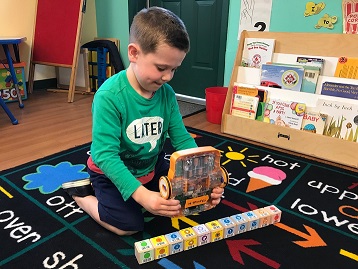Robotics in Early Childhood Education – Robotics Makes Elementary Coding Tangible, Concrete…and Screen-Free!
In the fourth part of the blog series, we share key reasons why early childhood educators should be incorporating elementary coding in their classrooms. In this blog, we are focusing on Key #4 – Robotics Makes Coding Tangible, Concrete…and Screen-Free! See the other blogs in this series about the importance of robots in early learning with STEAM learning tools:
- Key 1 – Robotics in Early Childhood Education – Coding Teaches STEAM, the Literacy of the 21st Century
- Key 2 – Robotics in Early Childhood Education – Coding Develops Computational Thinking Skills
- Key 3 – Robotics in Early Childhood Education – Technology Becomes the Playground
- Key 5 – Robotics in Early Childhood Education – Using Technology Breaks Down Engineering Stereotypes
- Key 6 – Robotics in Early Childhood Education – The Engineering Design Process Develops Grit and Perseverance
Early childhood is a wonderful time to sparks kids’ interest in coding, robotics, and engineering. Young children are naturally curious about the world around them. Today, that world includes technology. But how can educators promote positive, creative, and educational engagement with technology with our youngest learners? Integrating elementary coding through robotics is easier than you may think, with a hands-on, screen-free robot like KIBO. KIBO is an educational learning robot, where, in a screen-free way, young students learn STEAM concepts in a fun and creative way.
Robotics in Early Childhood Education – Robotics Makes Coding Tangible, Concrete…and Screen-Free!

Educational theorists have long recognized that young children think and learn best when moving, playing, building, and engaging with concrete objects. Traditional coding is often screen-based and abstract. But with educational robotics kits, children’s code affects the physical world – the robot moves and reacts based on the instructions the children give it. The robot is an “object to think with,” in Seymour Papert’s phrasing.
Even better, with KIBO, the programming language itself is tangible and concrete. Children program KIBO by sequencing physical wooden blocks, similar to familiar educational manipulatives like building blocks and Cuisenaire rods. Coding with KIBO’s wooden programming blocks requires no screen time for these young learners. Studies with KIBO demonstrate that young children benefit from connecting programming concepts to concrete, physical objects, reinforcing learning in an age-appropriate way.
Learn the 6 Key Benefits of Using Robotics with Your Youngest Students!
![]() Introduce coding and screen-free robotics into your early childhood classrooms – in a fun and playful way!
Introduce coding and screen-free robotics into your early childhood classrooms – in a fun and playful way!
Is Screen Free Really Better for Elementary Coding?
KIBO’s tangible coding using physical screen-free robots and wooden blocks addresses the learning styles and cognitive abilities of early childhood. In addition to the inherent value of limiting screen-time, elementary aged students learn better with concrete, physical manipulatives than abstract on-screen representations.
Dr. Bers, KinderLab’s Co-founder and Chief Scientist’s, DevTech Research Group recently completed a comparative study of two equivalent 5-day intensive curricula, one using KIBO and one using a screen-based coding tool. They found that the KIBO group performed 27% better than the screen-based group on tests of computational thinking skills including sequencing, understanding of loops and conditionals, and debugging.
As the study authors concluded, “Students in the tangible KIBO group scored higher across all four computational thinking categories in comparison to the [screen-based programming] group.” (Pugnali et al., 2017)
By translating the abstract concepts of coding tangible into a tangible, physical form, KIBO’s block-based coding lets young children learn these concepts quickly, naturally, and playfully.
KIBO’s Elementary Coding Offers Playful Learning
KIBO, the screen-free STEAM robot, offers an inviting, engaging platform for young learners to start their journey into coding, robotics and computational thinking. Elementary coding can be fun and creative, where KIBO’s block-based coding language gives children control over the robot’s movements, sounds, and sensors, allowing them to express their imaginations with code. And, when accompanied by our STEAM curriculum, young children are able to tell stories, create characters, and explore their world with KIBO.
Learn more about how the screen-free KIBO Robot can teach the fundamentals of programming in a fun and engaging way and our mission to introduce coding to young children by watching Dr. Marina Bers’ Tedx Talk – Young programmers — think playgrounds, not playpens.
Stay turned for the next blog on additional key reasons why robotics is important for young learners.
Supporting research:
- Papert, S. (1980). Mindstorms: Children, computers and powerful ideas. New York: Basic books.
- Bers, M. (2008), Blocks to robots: Learning with technology in the early childhood classroom. New York, NY: Teachers College Press.
- Pugnali, A., Sullivan, A., & Bers, M.U. (2017) The Impact of User Interface on Young Children’s Computational Thinking. Journal of Information Technology Education: Innovations in Practice, 16, 172-193.



















